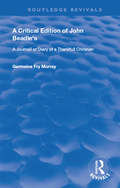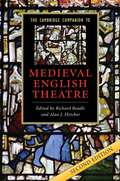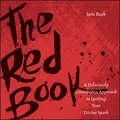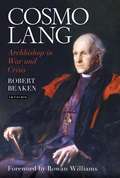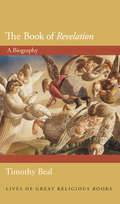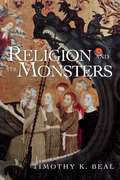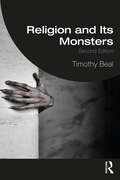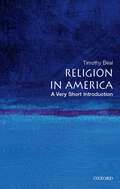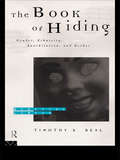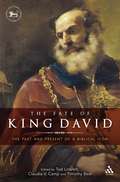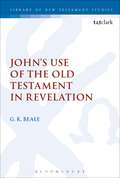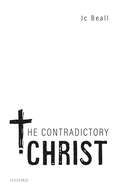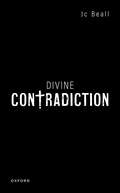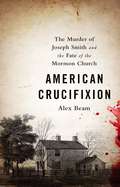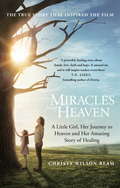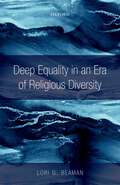- Table View
- List View
A Critical Edition of John Beadle's a Journall or Diary of a Thankfull Christian (Routledge Revivals)
by John BeadlePublished in 1996: The Book the author produced, A Journall or Diary of a Thankfull Christian is essentially a manual, a how-to book about how to write a spiritual diary; moreover, it is the only one of its kind written in seventeenth-century England.
The Cambridge Companion To Medieval English Theatre (Cambridge Companions To Literature Ser. (PDF))
by Richard Beadle Alan J. FletcherThe drama of the English Middle Ages is perennially popular with students and theatre audiences alike, and this is an updated edition of a book which has established itself as a standard guide to the field. The Cambridge Companion to Medieval English Theatre, second edition continues to provide an authoritative introduction and an up-to-date, illustrated guide to the mystery cycles, morality drama and saints' plays which flourished from the late fourteenth to the mid-sixteenth centuries. The book emphasises regional diversity in the period and engages with the literary and particularly the theatrical values of the plays. Existing chapters have been revised and updated where necessary, and there are three entirely new chapters, including one on the cultural significance of early drama. A thoroughly revised reference section includes a guide to scholarship and criticism, an enlarged classified bibliography and a chronological table.
The Red Book: A Deliciously Unorthodox Approach to Igniting Your Divine Spark
by Sera J. BeakThe Red Book is nothing less than a spiritual fire starter -- a combustible cocktail of Hindu Tantra and Zen Buddhism, Rumi and Carl Jung, goddesses and psychics, shaken with cosmic nudges, meaningful subway rides, haircuts, relationships, sex, dreams, and intuition. Author Sera Beak's unique hybrid perspective, hilarious personal anecdotes, and invaluable exercises encourage her readers to live more consciously so they can start making clearer choices across the board, from careers to relationships, politics to pop culture and everything in between. For smart, gutsy, spiritually curious women whose colorful and complicated lives aren’t reflected in most spirituality books, The Red Book is an open invitation to find your true self and start sharing that delicious truth with the world.
Cosmo Lang: Archbishop in War and Crisis
by Robert BeakenIn December 1936, at the height of the Abdication Crisis, Cosmo Gordon Lang, Archbishop of Canterbury held the fate of the British monarchy in his hands. Together with the Prime Minister Stanley Baldwin, he helped to manoeuvre Edward VIII from the throne and to replace him with the king's brother, the Duke of York, who was to become George VI. It was a move which would have far-reaching consequences for the course of British history.The period 1928-1942 saw some of the greatest political and social upheavals in modern British history. Lang, as Archbishop of Canterbury, led the Church of England through this tumultuous period and was a pivotal influence in political and religious decision-making. In this book, Robert Beaken provides a new perspective on Lang, including his considerable relationship with the Royal Family. Beaken also shows how Lang proved to be a sensitive leader during wartime, opposing any demonization of the enemy and showing compassion to conscientious objectors.Despite his central role at a time of flux, there has been little written on Lang since the original biography published in 1949 and history has not been kind to this intellectually gifted, but emotionally complex man. Although Lang has often been seen as a fairly unsuccessful archbishop who was resistant to change, Beaken shows that he was, in fact, an effective leader of the Anglican community at a time when the Church of England was internally divided over issues surrounding the Revised Prayer Book and its position in an ever-changing world. Lang's reputation is therefore ripe for reassessment. Drawing on previously unseen material and first-hand interviews, Beaken tells the story of a fascinating and complex man, who was, he argues, Britain's first 'modern' Archbishop of Canterbury.
The Book of Revelation: A Biography (Lives of Great Religious Books #29)
by Timothy BealThe life and times of the New Testament’s most mystifying and incendiary bookFew biblical books have been as revered and reviled as Revelation. Many hail it as the pinnacle of prophetic vision, the cornerstone of the biblical canon, and, for those with eyes to see, the key to understanding the past, present, and future. Others denounce it as the work of a disturbed individual whose horrific dreams of inhumane violence should never have been allowed into the Bible. Timothy Beal provides a concise cultural history of Revelation and the apocalyptic imaginations it has fueled.Taking readers from the book’s composition amid the Christian persecutions of first-century Rome to its enduring influence today in popular culture, media, and visual art, Beal explores the often wildly contradictory lives of this sometimes horrifying, sometimes inspiring biblical vision. He shows how such figures as Augustine and Hildegard of Bingen made Revelation central to their own mystical worldviews, and how, thanks to the vivid works of art it inspired, the book remained popular even as it was denounced by later church leaders such as Martin Luther. Attributed to a mysterious prophet identified only as John, Revelation speaks with a voice unlike any other in the Bible. Beal demonstrates how the book is a multimedia constellation of stories and images that mutate and evolve as they take hold in new contexts, and how Revelation is reinvented in the hearts and minds of each new generation.This succinct book traces how Revelation continues to inspire new diagrams of history, new fantasies of rapture, and new nightmares of being left behind.
The Book of Revelation: A Biography (Lives of Great Religious Books #29)
by Timothy BealThe life and times of the New Testament’s most mystifying and incendiary bookFew biblical books have been as revered and reviled as Revelation. Many hail it as the pinnacle of prophetic vision, the cornerstone of the biblical canon, and, for those with eyes to see, the key to understanding the past, present, and future. Others denounce it as the work of a disturbed individual whose horrific dreams of inhumane violence should never have been allowed into the Bible. Timothy Beal provides a concise cultural history of Revelation and the apocalyptic imaginations it has fueled.Taking readers from the book’s composition amid the Christian persecutions of first-century Rome to its enduring influence today in popular culture, media, and visual art, Beal explores the often wildly contradictory lives of this sometimes horrifying, sometimes inspiring biblical vision. He shows how such figures as Augustine and Hildegard of Bingen made Revelation central to their own mystical worldviews, and how, thanks to the vivid works of art it inspired, the book remained popular even as it was denounced by later church leaders such as Martin Luther. Attributed to a mysterious prophet identified only as John, Revelation speaks with a voice unlike any other in the Bible. Beal demonstrates how the book is a multimedia constellation of stories and images that mutate and evolve as they take hold in new contexts, and how Revelation is reinvented in the hearts and minds of each new generation.This succinct book traces how Revelation continues to inspire new diagrams of history, new fantasies of rapture, and new nightmares of being left behind.
The Book of Revelation: A Biography (Lives of Great Religious Books #29)
by Timothy BealThe life and times of the New Testament’s most mystifying and incendiary bookFew biblical books have been as revered and reviled as Revelation. Many hail it as the pinnacle of prophetic vision, the cornerstone of the biblical canon, and, for those with eyes to see, the key to understanding the past, present, and future. Others denounce it as the work of a disturbed individual whose horrific dreams of inhumane violence should never have been allowed into the Bible. Timothy Beal provides a concise cultural history of Revelation and the apocalyptic imaginations it has fueled.Taking readers from the book’s composition amid the Christian persecutions of first-century Rome to its enduring influence today in popular culture, media, and visual art, Beal explores the often wildly contradictory lives of this sometimes horrifying, sometimes inspiring biblical vision. He shows how such figures as Augustine and Hildegard of Bingen made Revelation central to their own mystical worldviews, and how, thanks to the vivid works of art it inspired, the book remained popular even as it was denounced by later church leaders such as Martin Luther. Attributed to a mysterious prophet identified only as John, Revelation speaks with a voice unlike any other in the Bible. Beal demonstrates how the book is a multimedia constellation of stories and images that mutate and evolve as they take hold in new contexts, and how Revelation is reinvented in the hearts and minds of each new generation.This succinct book traces how Revelation continues to inspire new diagrams of history, new fantasies of rapture, and new nightmares of being left behind.
Religion and Its Monsters
by Timothy BealReligion's great and powerful mystery fascinates us, but it also terrifies. So too the monsters that haunt the stories of the Judeo-Christian mythos and earlier traditions: Leviathan, Behemoth, dragons, and other beasts. In this unusual and provocative book, Timothy K. Beal writes about the monsters that lurk in our religious texts, and about how monsters and religion are deeply entwined. Horror and faith are inextricable. Ans as monsters are part of religious texts and traditions, so religion lurks in the modern horror genre, from its birth in Dante's Inferno to the contemporary spookiness of H.P. Lovecraft and the Hellraiser films. Religion and Its Monsters is essential reading for students of religion and popular culture, as well as any readers with an interest in horror.
Religion and Its Monsters
by Timothy BealReligion's great and powerful mystery fascinates us, but it also terrifies. So too the monsters that haunt the stories of the Judeo-Christian mythos and earlier traditions: Leviathan, Behemoth, dragons, and other beasts. In this unusual and provocative book, Timothy K. Beal writes about the monsters that lurk in our religious texts, and about how monsters and religion are deeply entwined. Horror and faith are inextricable. Ans as monsters are part of religious texts and traditions, so religion lurks in the modern horror genre, from its birth in Dante's Inferno to the contemporary spookiness of H.P. Lovecraft and the Hellraiser films. Religion and Its Monsters is essential reading for students of religion and popular culture, as well as any readers with an interest in horror.
Religion and Its Monsters
by Timothy BealReligious encounters with mystery can be fascinating, but also terrifying. So too when it comes to encounters with the monsters that haunt Jewish and Christian traditions. Religion has a lot to do with horror, and horror has a lot to do with religion. Religion has its monsters, and monsters have their religion. In this unusual and provocative book, Timothy Beal explores how religion, horror, and the monstrous are deeply intertwined. This new edition has been thoughtfully updated, reflecting on developments in the field over the past two decades and highlighting its contributions to emerging conversations. It also features a new chapter, "Gods, Monsters, and Machines," which engages cultural fascinations and anxieties about technologies of artificial intelligence and machine learning as they relate to religion and the monstrous at the dawn of the Anthropocene. Religion and Its Monsters is essential reading for students and scholars of religion and popular culture, as well as for any readers with an interest in horror theory or monster theory.
Religion and Its Monsters
by Timothy BealReligious encounters with mystery can be fascinating, but also terrifying. So too when it comes to encounters with the monsters that haunt Jewish and Christian traditions. Religion has a lot to do with horror, and horror has a lot to do with religion. Religion has its monsters, and monsters have their religion. In this unusual and provocative book, Timothy Beal explores how religion, horror, and the monstrous are deeply intertwined. This new edition has been thoughtfully updated, reflecting on developments in the field over the past two decades and highlighting its contributions to emerging conversations. It also features a new chapter, "Gods, Monsters, and Machines," which engages cultural fascinations and anxieties about technologies of artificial intelligence and machine learning as they relate to religion and the monstrous at the dawn of the Anthropocene. Religion and Its Monsters is essential reading for students and scholars of religion and popular culture, as well as for any readers with an interest in horror theory or monster theory.
Religion in America: A Very Short Introduction (Very Short Introductions)
by Timothy BealIt's hard to think of a single aspect of American culture, past or present, in which religion has not played a major role. The roles religion plays, moreover, become more bewilderingly complex and diverse every day. For all those who want--whether out of curiosity, necessity, or civic duty--a vivid picture and fuller understanding of the current reality of religion in America, this Very Short Introduction is the go-to book they need. Timothy Beal describes many aspects of religion in contemporary America that are typically ignored in other books on the subject, including religion in popular culture and counter-cultural groups; the growing phenomenon of "hybrid" religious identities, both individual and collective; the expanding numbers of new religious movements, or NRMs, in America; and interesting examples of "outsider religion," such as Paradise Gardens in Georgia and the People Love People House of God in Ohio. He also offers an engaging overview of the history of religion in America, from Native American traditions to the present day. Beal sees three major forces shaping the present and future of religion in America: first, unprecedented religious diversity, which will continue to grow in the decades to come; second, the information revolution and the emergence of a new network society; and third, the rise of consumer culture. Taken together, these forces offer the potential to create a new American pluralism that would enrich society in unimaginable ways, but they also threaten the great ideal of e pluribus unum. With visual aids that help readers navigate America's diverse religious landscape, this informative, thoughtful, and provocative book is a must-read in the emerging public conversation concerning religion in America. About the Series: Combining authority with wit, accessibility, and style, Very Short Introductions offer an introduction to some of life's most interesting topics. Written by experts for the newcomer, they demonstrate the finest contemporary thinking about the central problems and issues in hundreds of key topics, from philosophy to Freud, quantum theory to Islam.
The Book of Hiding: Gender, Ethnicity, Annihilation, and Esther (Biblical Limits)
by Timothy K. BealThe Book of Hiding offers a fluent and erudite analysis of the parallels between the Bible and contemporary discussions of gender, ethnicity and social ambiguity. Beal focuses particularly on the traditionally marginalised book of Esther, in order to examine closely the categories of self and other in relation to religion, sexism, nationalism, and the ever-looming legacies and future possibilities of annihilation. Beal applies the critical tools of contemporary theorists, such as Cixous, Irigaray and Levinas, challenging widely held assumptions about the moral and life-affirming message of Scripture and even about the presence of God in the book of Esther. The Book of Hiding draws together a variety of different perspectives and disciplines, creating a unique space for dialogue raising new questions and reconsidering old assumptions, which is profoundly interesting and well-articulated.
The Book of Hiding: Gender, Ethnicity, Annihilation, and Esther (Biblical Limits)
by Timothy K. BealThe Book of Hiding offers a fluent and erudite analysis of the parallels between the Bible and contemporary discussions of gender, ethnicity and social ambiguity. Beal focuses particularly on the traditionally marginalised book of Esther, in order to examine closely the categories of self and other in relation to religion, sexism, nationalism, and the ever-looming legacies and future possibilities of annihilation. Beal applies the critical tools of contemporary theorists, such as Cixous, Irigaray and Levinas, challenging widely held assumptions about the moral and life-affirming message of Scripture and even about the presence of God in the book of Esther. The Book of Hiding draws together a variety of different perspectives and disciplines, creating a unique space for dialogue raising new questions and reconsidering old assumptions, which is profoundly interesting and well-articulated.
The Fate of King David: The Past and Present of a Biblical Icon (The Library of Hebrew Bible/Old Testament Studies)
by Timothy Beal Tod Linafelt Claudia V. CampCelebrating the five hundredth volume, this Festschrift honors David M. Gunn, one of the founders of the Journal of Old Testament Studies, later the Library of Hebrew Bible/Old Testament Studies, and offers essays representing cutting-edge interpretations of the David material in the Hebrew Bible and later literary and popular culture. Essays in Part One, Relating to David, present David in relationship to other characters in Samuel. These essays demonstrate the value of close reading, analysis of literary structure, and creative, disciplined readerly imagination in interpreting biblical texts in general and understanding the character of David in particular. Part Two, Reading David, expands the narrative horizon. These essays analyze the use of the David character in larger biblical narrative contexts. David is understood as a literary icon that communicates and disrupts meaning in different ways in different context. More complex modes of interpretation enter in, including theories of metaphor, memory and history, psychoanalysis, and post-colonialism. Part Three, Singing David, shifts the focus to the portrayal of David as singer and psalmist, interweaving in mutually informative ways both with visual evidence from the ancient Near East depicting court musicians and with the titles and language of the biblical psalms. Part Four, Receiving David, highlights moments in the long history of interpretation of the king in popular culture, including poetry, visual art, theatre, and children's literature. Finally, the essays in Part Five, Re-locating David, represent some of the intellectually and ethically vital interpretative work going on in contexts outside the U.S. and Europe.
John's Use of the Old Testament in Revelation (The Library of New Testament Studies #166)
by Gregory K. BealeThis book explores the variety of ways John contextually uses the Old Testament in the Apocalypse. The introduction surveys and evaluates recent studies, which have been divided over the issue of whether or not John uses the Old Testament with sensitivity to its original literary context (Beale, Fekkes and Bauckham argue in the affirmative, while Ruiz and Moyise contend that this was not John's focus and see implications for 'reader-response criticism'). The remainder of the book looks at various ways in which John uses the Old Testament and argues that there is a reciprocal interpretative relationship between the Old Testament and the Apocalypse. Studies of special interest concern the bearing of the Old Testament on Revelation's eschatology, on the issue of the millennium, and on the thorny problem of the grammatical solecisms.
The Contradictory Christ (Oxford Studies in Analytic Theology)
by Jc BeallIn this ground-breaking study, Jc Beall shows that the fundamental "problem" of Christology is simple to see from the role that Christ occupies: the Christ figure is to have the divine and essentially limitless properties of the one and only God but Christ is equally to have the human, essentially limit-imposing properties involved in human nature, limits essentially involved in being human. The role that Christ occupies thereby appears to demand a contradiction: all of the limitlessness of God, and all of the limits of humans. This book lays out Beall's contradictory account of Jesus Christ — and thereby a contradictory Christian theology.
The Contradictory Christ (Oxford Studies in Analytic Theology)
by Jc BeallIn this ground-breaking study, Jc Beall shows that the fundamental "problem" of Christology is simple to see from the role that Christ occupies: the Christ figure is to have the divine and essentially limitless properties of the one and only God but Christ is equally to have the human, essentially limit-imposing properties involved in human nature, limits essentially involved in being human. The role that Christ occupies thereby appears to demand a contradiction: all of the limitlessness of God, and all of the limits of humans. This book lays out Beall's contradictory account of Jesus Christ — and thereby a contradictory Christian theology.
Divine Contradiction (Oxford Studies in Analytic Theology)
by Prof Jc BeallBuilding on his paradigm-shifting work on the incarnation in The Contradictory Christ (OUP, 2021), Jc Beall extends a robust contradictory theology with an account of the trinity. Throughout the history of the Christian church, heretics, apophatics, mystics, atheists, and many others have long proclaimed that the doctrine of the trinity - one of the central doctrines of the Christian faith - is contradictory. In this work, Beall agrees; however, as Beall convincingly argues, one needn't abandon orthodoxy, play language games, inflate one's metaphysics, nor abandon the standard faith in the face of such divine contradiction. Instead, one can accept central axioms of the trinity at face value and, with a suitable account of logical entailment, accept the 'contradictory truths' thereby entailed. With the clarity and precision that only a logician could provide, Beall provided theology and the Christian church in general with a very simple and viable (and arguably correct) model of divine reality. Unlike the vast number of theologians and philosophers before him, Beall rejects the quest for a logically consistent account of divine reality. The triune god (viz., God) is truly and fully described only via contradiction. As such, attempts to remove the contradiction are attempts to remove truths of God.
Divine Contradiction (Oxford Studies in Analytic Theology)
by Prof Jc BeallBuilding on his paradigm-shifting work on the incarnation in The Contradictory Christ (OUP, 2021), Jc Beall extends a robust contradictory theology with an account of the trinity. Throughout the history of the Christian church, heretics, apophatics, mystics, atheists, and many others have long proclaimed that the doctrine of the trinity - one of the central doctrines of the Christian faith - is contradictory. In this work, Beall agrees; however, as Beall convincingly argues, one needn't abandon orthodoxy, play language games, inflate one's metaphysics, nor abandon the standard faith in the face of such divine contradiction. Instead, one can accept central axioms of the trinity at face value and, with a suitable account of logical entailment, accept the 'contradictory truths' thereby entailed. With the clarity and precision that only a logician could provide, Beall provided theology and the Christian church in general with a very simple and viable (and arguably correct) model of divine reality. Unlike the vast number of theologians and philosophers before him, Beall rejects the quest for a logically consistent account of divine reality. The triune god (viz., God) is truly and fully described only via contradiction. As such, attempts to remove the contradiction are attempts to remove truths of God.
American Crucifixion: The Murder of Joseph Smith and the Fate of the Mormon Church
by Alex BeamOn June 27, 1844, a mob stormed the jail in the dusty frontier town of Carthage, Illinois. Clamorous and angry, they were hunting down a man they saw as a grave threat to their otherwise quiet lives: the founding prophet of Mormonism, Joseph Smith. They wanted blood.At thirty-nine years old, Smith had already lived an outsized life. In addition to starting his own religion and creating his own "Golden Bible”-the Book of Mormon-he had worked as a water-dowser and treasure hunter. He'd led his people to Ohio, then Missouri, then Illinois, where he founded a city larger than fledgling Chicago. He was running for president. And, secretly, he had married more than thirty women.In American Crucifixion, Alex Beam tells how Smith went from charismatic leader to public enemy: How his most seismic revelation-the doctrine of polygamy-created a rift among his people; how that schism turned to violence; and how, ultimately, Smith could not escape the consequences of his ambition and pride.Mormonism is America's largest and most enduring native religion, and the "martyrdom” of Joseph Smith is one of its transformational events. Smith's brutal assassination propelled the Mormons to colonize the American West and claim their place in the mainstream of American history. American Crucifixion is a gripping story of scandal and violence, with deep roots in our national identity.
American Crucifixion: The Murder of Joseph Smith and the Fate of the Mormon Church
by Alex BeamOn June 27, 1844, a mob stormed the jail in the dusty frontier town of Carthage, Illinois. Clamorous and angry, they were hunting down a man they saw as a grave threat to their otherwise quiet lives: the founding prophet of Mormonism, Joseph Smith. They wanted blood. At thirty-nine years old, Smith had already lived an outsized life. In addition to starting his own religion and creating his own "Golden Bible" -- the Book of Mormon -- he had worked as a water-dowser and treasure hunter. He'd led his people to Ohio, then Missouri, then Illinois, where he founded a city larger than fledgling Chicago. He was running for president. And, secretly, he had married more than thirty women. In American Crucifixion, Alex Beam tells how Smith went from charismatic leader to public enemy: How his most seismic revelation -- the doctrine of polygamy -- created a rift among his people; how that schism turned to violence; and how, ultimately, Smith could not escape the consequences of his ambition and pride. Mormonism is America's largest and most enduring native religion, and the "martyrdom" of Joseph Smith is one of its transformational events. Smith's brutal assassination propelled the Mormons to colonize the American West and claim their place in the mainstream of American history. American Crucifixion is a gripping story of scandal and violence, with deep roots in our national identity.
Miracles from Heaven: A Little Girl, Her Journey to Heaven and Her Amazing Story of Healing
by Christy Wilson BeamAnnabel Beam is one of three sisters raised in the Texas countryside by loving parents. But what should have been a happy, carefree childhood was blighted when Annabel developed a painful and seemingly incurable digestive disorder. Her parents spared no expense in the search for a cure, but medical experts assured them there was none. On a rare day when Annabel felt well enough to play outside, she was climbing an old hollowed-out tree when a branch snapped and she fell, head first, thirty feet down inside the tree. Miraculously, she survived the fall but was knocked unconscious. Rescued and later released from hospital, Annabel told her mother, 'you know I went to heaven when I was in that tree'. Annabel shared with her mother her amazing experience of talking to God, who told her that it wasn't her time and that she must go back. What happened next was the greatest miracle of all. Annabel was inexplicably cured of her illness and her doctors could offer no explanation. Written by Annabel's mother Christy, Miracles from Heaven is the story of a little girl's - and a family's - inspiring journey. Deeply moving and heartwarming, the book recounts the fateful day of the accident, Annabel's description of her time in heaven and her miraculous recovery. This is the story of how one family never gave up hope.
Deep Equality in an Era of Religious Diversity
by Lori G. BeamanWhile religious conflict receives plenty of attention, the everyday negotiation of religious diversity does not. Questions of how to accommodate religious minorities and of the limits of tolerance resonate in a variety of contexts and have become central preoccupations for many Western democracies. What might we see if we turned our attention to the positive narratives and success stories of the everyday working out of religious difference? Rather than 'tolerance' and 'accommodation', and through the stories of ordinary people, this book traces deep equality, which is found in the respect, humour, and friendship of seemingly mundane interactions. Deep Equality in an Era of Religious Diversity shows that the telling of such stories can create an alternative narrative to that of diversity as a problem to be solved. It explores the non-event, or micro-processes of interaction that constitute the foundation for deep equality and the conditions under which deep equality emerges, exists, and sometimes flourishes. Through a systematic search for and examination of such narratives, Lori G. Beaman demonstrates the possibility of uncovering, revealing, and recovering deep equality—a recovery that is vital to living in an increasingly diverse society. In achieving deep equality, identities are fluid, shifting in importance and structure as social interaction unfolds. Rigid identity imaginings, especially religious identities, block our vision to the complexities of social life and press us into corners that trap us in identities that we often ourselves do not recognize, want, or know how to escape. Although the focus of this study is deep equality and its existence and persistence in relation to religious difference, deep equality is located beyond the realm of religion. Beaman draws from the work of those whose primary focus is not in fact religion, and who are doing their own 'deep equality' work in other domains, illustrating especially why equality matters. By retelling and exploring stories of negotiation it is possible to reshape our social imaginary to better facilitate what works, which varies from place to place and time to time.
Deep Equality in an Era of Religious Diversity
by Lori G. BeamanWhile religious conflict receives plenty of attention, the everyday negotiation of religious diversity does not. Questions of how to accommodate religious minorities and of the limits of tolerance resonate in a variety of contexts and have become central preoccupations for many Western democracies. What might we see if we turned our attention to the positive narratives and success stories of the everyday working out of religious difference? Rather than 'tolerance' and 'accommodation', and through the stories of ordinary people, this book traces deep equality, which is found in the respect, humour, and friendship of seemingly mundane interactions. Deep Equality in an Era of Religious Diversity shows that the telling of such stories can create an alternative narrative to that of diversity as a problem to be solved. It explores the non-event, or micro-processes of interaction that constitute the foundation for deep equality and the conditions under which deep equality emerges, exists, and sometimes flourishes. Through a systematic search for and examination of such narratives, Lori G. Beaman demonstrates the possibility of uncovering, revealing, and recovering deep equality—a recovery that is vital to living in an increasingly diverse society. In achieving deep equality, identities are fluid, shifting in importance and structure as social interaction unfolds. Rigid identity imaginings, especially religious identities, block our vision to the complexities of social life and press us into corners that trap us in identities that we often ourselves do not recognize, want, or know how to escape. Although the focus of this study is deep equality and its existence and persistence in relation to religious difference, deep equality is located beyond the realm of religion. Beaman draws from the work of those whose primary focus is not in fact religion, and who are doing their own 'deep equality' work in other domains, illustrating especially why equality matters. By retelling and exploring stories of negotiation it is possible to reshape our social imaginary to better facilitate what works, which varies from place to place and time to time.
